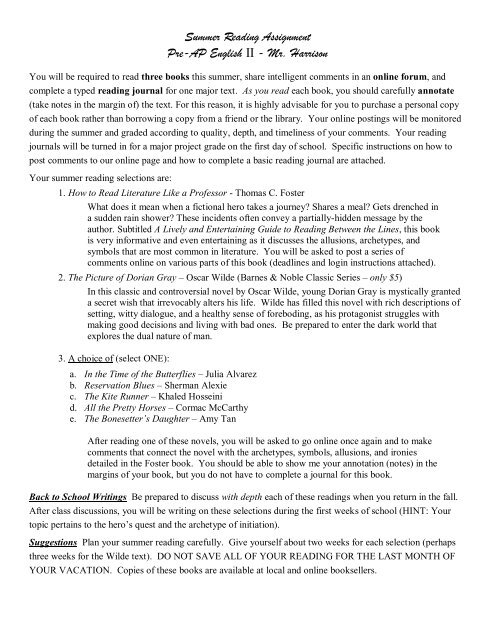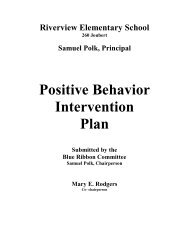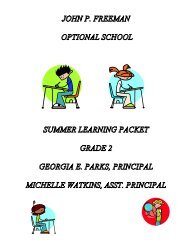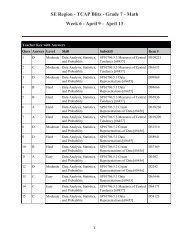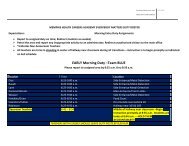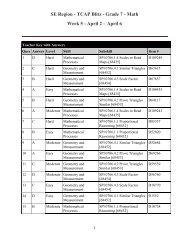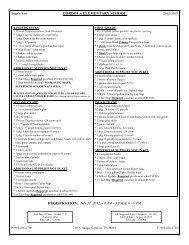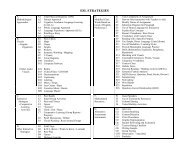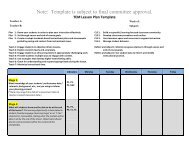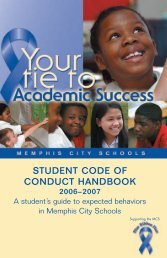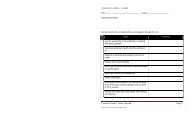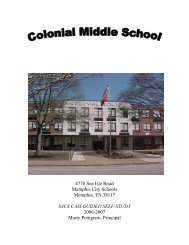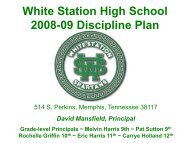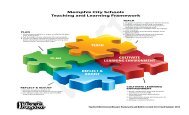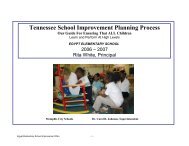Pre-AP Summer Reading Assignment (Grade 10)
Pre-AP Summer Reading Assignment (Grade 10)
Pre-AP Summer Reading Assignment (Grade 10)
- No tags were found...
Create successful ePaper yourself
Turn your PDF publications into a flip-book with our unique Google optimized e-Paper software.
<strong>Summer</strong> <strong>Reading</strong> <strong>Assignment</strong><strong>Pre</strong>-<strong>AP</strong> English II - Mr. HarrisonYou will be required to read three books this summer, share intelligent comments in an online forum, andcomplete a typed reading journal for one major text. As you read each book, you should carefully annotate(take notes in the margin of) the text. For this reason, it is highly advisable for you to purchase a personal copyof each book rather than borrowing a copy from a friend or the library. Your online postings will be monitoredduring the summer and graded according to quality, depth, and timeliness of your comments. Your readingjournals will be turned in for a major project grade on the first day of school. Specific instructions on how topost comments to our online page and how to complete a basic reading journal are attached.Your summer reading selections are:1. How to Read Literature Like a Professor - Thomas C. FosterWhat does it mean when a fictional hero takes a journey? Shares a meal? Gets drenched ina sudden rain shower? These incidents often convey a partially-hidden message by theauthor. Subtitled A Lively and Entertaining Guide to <strong>Reading</strong> Between the Lines, this bookis very informative and even entertaining as it discusses the allusions, archetypes, andsymbols that are most common in literature. You will be asked to post a series ofcomments online on various parts of this book (deadlines and login instructions attached).2. The Picture of Dorian Gray – Oscar Wilde (Barnes & Noble Classic Series – only $5)In this classic and controversial novel by Oscar Wilde, young Dorian Gray is mystically granteda secret wish that irrevocably alters his life. Wilde has filled this novel with rich descriptions ofsetting, witty dialogue, and a healthy sense of foreboding, as his protagonist struggles withmaking good decisions and living with bad ones. Be prepared to enter the dark world thatexplores the dual nature of man.3. A choice of (select ONE):a. In the Time of the Butterflies – Julia Alvarezb. Reservation Blues – Sherman Alexiec. The Kite Runner – Khaled Hosseinid. All the <strong>Pre</strong>tty Horses – Cormac McCarthye. The Bonesetter’s Daughter – Amy TanAfter reading one of these novels, you will be asked to go online once again and to makecomments that connect the novel with the archetypes, symbols, allusions, and ironiesdetailed in the Foster book. You should be able to show me your annotation (notes) in themargins of your book, but you do not have to complete a journal for this book.Back to School Writings Be prepared to discuss with depth each of these readings when you return in the fall.After class discussions, you will be writing on these selections during the first weeks of school (HINT: Yourtopic pertains to the hero’s quest and the archetype of initiation).Suggestions Plan your summer reading carefully. Give yourself about two weeks for each selection (perhapsthree weeks for the Wilde text). DO NOT SAVE ALL OF YOUR READING FOR THE LAST MONTH OFYOUR VACATION. Copies of these books are available at local and online booksellers.
How to Post Comments to Your Classmates OnlineAs you read Foster’s How to Read Literature Like a Professor, you will be required to make connectionsbetween the information presented in certain chapters and movies, novels, and other stories you are alreadyfamiliar with. All that is required here is to make a comment like: “What Foster says about quests reminds meof Hiro Nakamura from the NBC show Heroes. He’s always talking to his friend Ando about his ‘mission’ tosave the world.” It’s that simple. You may not use examples already given in the Foster text. You mayrespond to what others say, but simply “piggybacking” on others’ comments does not qualify for earning yourcredit; your contributions must be original.Later in the summer, after reading Dorian Gray and your choice book (from the list), you will go online twomore times: once to give ONE example of ONE of the suggested motifs in Dorian Gray, and again to connectthe Foster text to the choice novel. Therefore, before returning to school in the fall, you will have posted aminimum of SIX times. The following schedule shows your deadlines for each posting. I will monitor yourparticipation for a grade, and no credit will be given for postings made beyond the deadline. Also, postingcomments that would be inappropriate for the classroom will NOT be tolerated. Those who do so endanger notonly their grades on this assignment but also their conduct grades. This assignment will be part of your firstmajor test/project grade for the first grading period (Test/Project category = 30-35%).Online Posting DeadlinesJune 12June 19June 26HTRLLaP Ch. 1-3 (Heroic quests, meals, and vampires)HTRLLaP Ch. 5-9 (Allusions)HTRLLaP Ch. <strong>10</strong>-15 and 18 (Symbols)July 3 HTRLLaP Ch. 19-24 (Setting and character archetypes)July 31 Motifs in Wilde’s Picture of Dorian Gray – Find ONE, unique quote (different from the othersthat have been posted) that mentions flowers, hands, eyes, mouth, voices, curtain, pall, mask,mirror, white, red, or an allusion (Biblical, mythological, etc.). Cite the page #.July 31 Connection between HTRLLaP and your Choice Book (ONE REQUIRED, but a secondconnection may be made to make up ONE earlier missed deadline. This must be clearlymarked - as in “Make-Up Comment.” Again, ONE MAKE-UP POSTING MAXIMUM.IMPORTANT: You may post your connections and comments at any time prior to the deadline. In fact, you can easily complete theFoster text and post on the first four topics within the first week of summer. Anyone who will be away from internet access because ofcamps or family vacation should strive to complete his or her postings prior to traveling.How and where to post comments? The site that we are using for this assignment is www.NiceNet.org. Thissite is free for you to use and is devoid of obnoxious advertising.1. Go to www.nicenet.org (please notice the “.org”, not “.com”).2. Locate the box on the right that says, “New Users Start Here,” and click on “Join a Class.”3. In the box labeled “Class Key,” type the following code: 3346065P984. Create a user name and password. Your user name must be your first name and your last name (for instance,I would be “Scott Harrison”). Your password is entirely up to you, but I strongly encourage you to writeboth of these down inside the front cover of your copy of the Foster book.5. Click on “Conferencing” (on the left), locate the thread you wish to post to, and click on the topic for anexample of the type of posting that I am expecting. You may then add your own comment.Why an online discussion? The best way to develop critical reading and rhetorical analysis skills, which arethe basis for college-level literary analysis, is through the experience of class discussions following readings.Unfortunately, summer schedules do not afford us the opportunity to come together for such discussions. Theonline site is the most convenient way for you to share ideas with your classmates over the summer months. Iexpect you not only to post your original thoughts, but also to read and respond to the posts of others.
How to Keep a <strong>Reading</strong> JournalInstead of writing a book report on your readings, you will keep a reading journal for Oscar Wilde’s Picture ofDorian Gray. The reading journal will count as a major project/test grade and is due on the first day of school,August 5th (25 points will be deducted for failing to meet this deadline). Points will be deducted for notcompleting each part of each reading journal as described below.What should your journal include? Each basic reading journal has five required partsIMPRESSIONS/CONNECTIONS: Were there scenes in the book that reminded you of the situationalor character archetypes in the Foster text? What about symbols or allusions? Record anything thatreminded you of people, places, events, or situations from real life, from a movie, or from anotherstory. What lessons did you learn? Record a minimum of TEN Impressions or Connections that you makeas you read this novel. Use COMPLETE SENTENCES.QUESTIONS: Good readers are involved in their reading. List any questions that come to your mind asyou read. Use question words such as who, what, when, where, how, and especially WHY. In the leftcolumn, record the quote and page number you were reading when the question occurred to you. Ask aminimum of TEN questions for each journal (at least five of your questions must be a WHY orHOW question).INTERESTING PHRASING: Pay attention to the author’s use of words, especially the way people,places, or events are described. Did the author say something in a clever way? Does he reveal somethingabout a character using a simile or metaphor? Are certain passages so vivid that they pull you into thescene? Record at least TEN brief quotes and the page number where each can be found. Tell why youchose each and what you think that author is trying to accomplish.SIGNIFICANT QUOTES: Look for lines spoken by characters that reveal his or her thoughts about hisor her current situation. Watch for remarks that characters make about life or about dealing withissues; these may reveal a major change or growth in the character. Sometimes the author maydirectly tell us what the character has learned; at other times, the author tells us indirectly throughdialogue. Such quotes are usually related to themes in the book. In the left column, write the entirequote (may be more than one sentence), identify the speaker of the quote, and cite the page numberwhere the quote may be found. You are required to cite a minimum of TEN important quotes for yourjournal.NEW WORDS: Locate and choose at least FIFTEEN unfamiliar words to define from the novel. In the leftcolumn, type the entire sentence in which the word is found (cite page number). Then, in the right columninclude a brief definition or synonym (use a dictionary). Also, tell whether the word is one that you have“never heard before” or one that you have heard but are “uncomfortable using” yourself. If you find that theword names some object that is out-of-use, you should pick another word (or just avoid nouns).How should my journal look? The final journal must be turned in TYPED. You should create a two-columnformat (similar to dialectical journals, for those of you who are familiar) with a direct quote in the left columnand your thoughts or comments in the right column. If you are using Microsoft Word, the easiest way toformat your document is to insert a table that is two columns wide. A direct quote may come from narration ordialogue. Each direct quote should be cited with a page number. Group each type quote first by category,then chronologically (all of your “Impressions/Connections” should appear together and be arranged in orderof appearance in the book). Since journaling is a habit I would like for you to develop as you read, you shouldmake handwritten notes in the margins of your book. Your typed journal should be headed with your name,the title and author of the book, and the date you complete the journal.What if I have a question this summer? If you get stuck or do not understand the instructions, you may reachme by e-mail at ascottharrison@yahoo.com. However, I will have NO internet access from 7/4 – 7/21.


